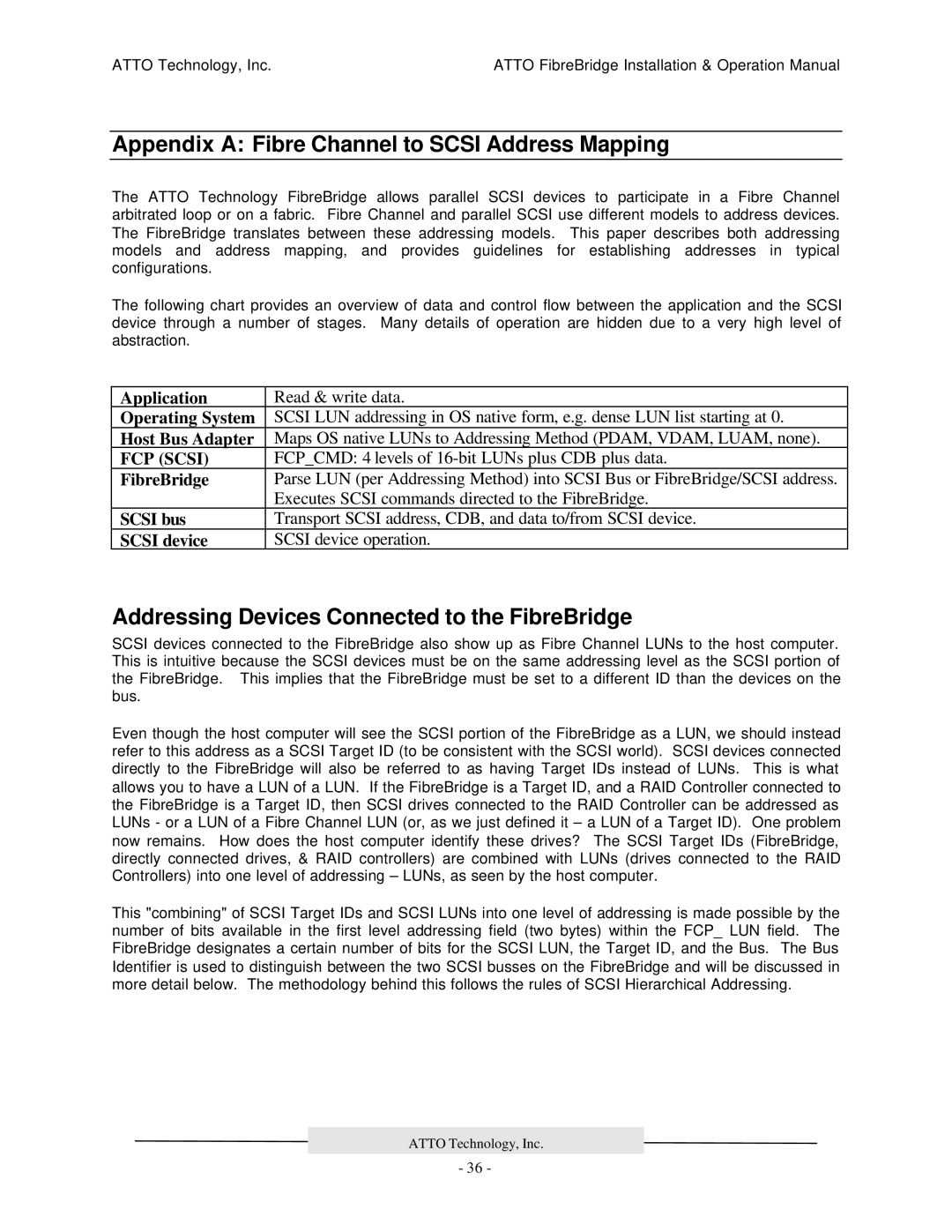
ATTO Technology, Inc. | ATTO FibreBridge Installation & Operation Manual |
Appendix A: Fibre Channel to SCSI Address Mapping
The ATTO Technology FibreBridge allows parallel SCSI devices to participate in a Fibre Channel arbitrated loop or on a fabric. Fibre Channel and parallel SCSI use different models to address devices. The FibreBridge translates between these addressing models. This paper describes both addressing models and address mapping, and provides guidelines for establishing addresses in typical configurations.
The following chart provides an overview of data and control flow between the application and the SCSI device through a number of stages. Many details of operation are hidden due to a very high level of abstraction.
Application | Read & write data. |
Operating System | SCSI LUN addressing in OS native form, e.g. dense LUN list starting at 0. |
Host Bus Adapter | Maps OS native LUNs to Addressing Method (PDAM, VDAM, LUAM, none). |
FCP (SCSI) | FCP_CMD: 4 levels of |
FibreBridge | Parse LUN (per Addressing Method) into SCSI Bus or FibreBridge/SCSI address. |
| Executes SCSI commands directed to the FibreBridge. |
SCSI bus | Transport SCSI address, CDB, and data to/from SCSI device. |
SCSI device | SCSI device operation. |
Addressing Devices Connected to the FibreBridge
SCSI devices connected to the FibreBridge also show up as Fibre Channel LUNs to the host computer. This is intuitive because the SCSI devices must be on the same addressing level as the SCSI portion of the FibreBridge. This implies that the FibreBridge must be set to a different ID than the devices on the bus.
Even though the host computer will see the SCSI portion of the FibreBridge as a LUN, we should instead refer to this address as a SCSI Target ID (to be consistent with the SCSI world). SCSI devices connected directly to the FibreBridge will also be referred to as having Target IDs instead of LUNs. This is what allows you to have a LUN of a LUN. If the FibreBridge is a Target ID, and a RAID Controller connected to the FibreBridge is a Target ID, then SCSI drives connected to the RAID Controller can be addressed as LUNs - or a LUN of a Fibre Channel LUN (or, as we just defined it – a LUN of a Target ID). One problem now remains. How does the host computer identify these drives? The SCSI Target IDs (FibreBridge, directly connected drives, & RAID controllers) are combined with LUNs (drives connected to the RAID Controllers) into one level of addressing – LUNs, as seen by the host computer.
This "combining" of SCSI Target IDs and SCSI LUNs into one level of addressing is made possible by the number of bits available in the first level addressing field (two bytes) within the FCP_ LUN field. The FibreBridge designates a certain number of bits for the SCSI LUN, the Target ID, and the Bus. The Bus Identifier is used to distinguish between the two SCSI busses on the FibreBridge and will be discussed in more detail below. The methodology behind this follows the rules of SCSI Hierarchical Addressing.
ATTO Technology, Inc.
- 36 -
